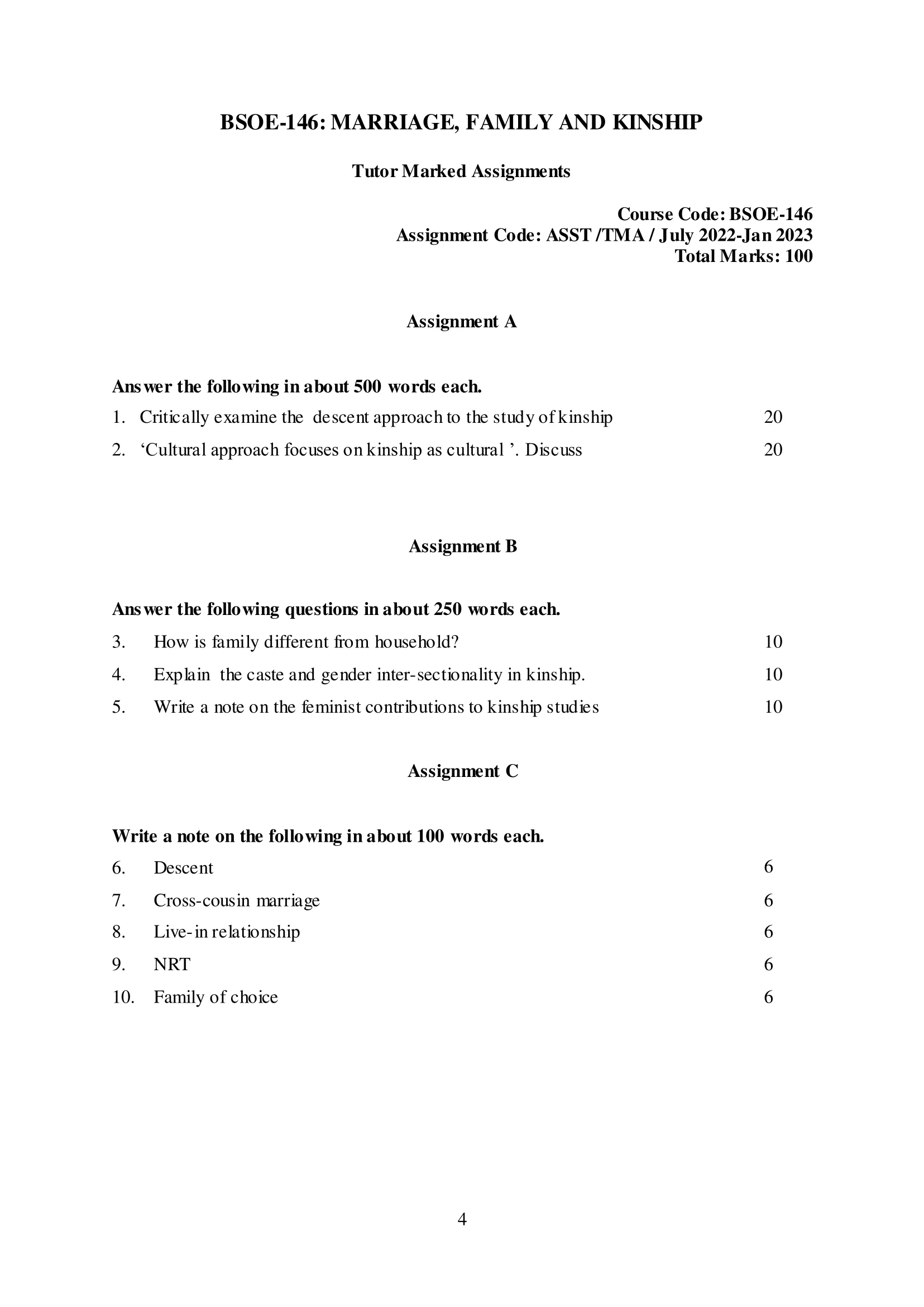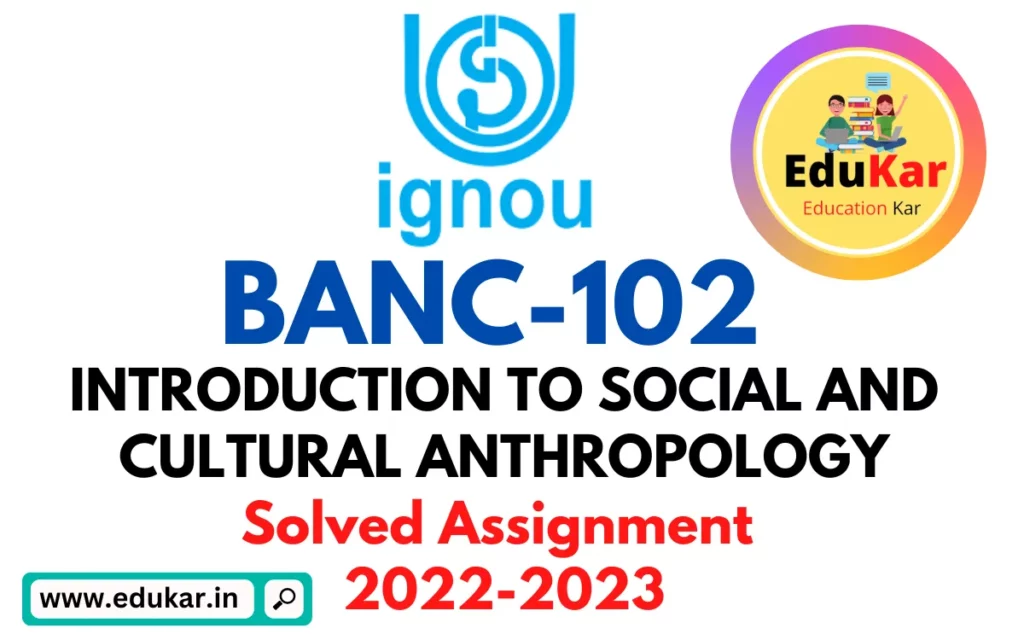Contents
- 1 Assignment A
- 2 Answer the following in about 500 words each.
- 3 1. Critically examine the descent approach to the study of kinship.
- 4 2. ‘Cultural approach focuses on kinship as cultural ’.
- 5 Assignment B
- 6 Answer the following questions in about 250 words each.
- 7 3. How is family different from household?
- 8 4. Explain the caste and gender inter-sectionality in kinship.
- 9 5. Write a note on the feminist contributions to kinship studies.
- 10 Assignment C
- 11 Write a note on the following in about 100 words each.
- 12 6. Descent
- 13 7. Cross-cousin marriage
- 14 8. Live-in relationship
- 15 9. NRT
- 16 10. Family of choice

| Title | BSOE-146: IGNOU BAG Solved Assignment 2022-2023 |
| University | IGNOU |
| Degree | Bachelor Degree Programme |
| Course Code | BSOE-146 |
| Course Name | MARRIAGE, FAMILY & KINSHIP |
| Programme Name | Bachelor of Arts (General) |
| Programme Code | BAG |
| Total Marks | 100 |
| Year | 2022-2023 |
| Language | English |
| Assignment Code | ASST /TMA / July 2022-Jan 2023 |
| Assignment PDF | Click Here |
| Last Date for Submission of Assignment: | For June Examination: 31st April For December Examination: 30th September |

Assignment A
Answer the following in about 500 words each.
1. Critically examine the descent approach to the study of kinship.
Ans: The descent approach to the study of kinship is a prominent theoretical framework in anthropology that explores how social relationships are defined and maintained within kinship systems. This approach focuses on tracing the line of descent or genealogical ties between individuals to determine their positions and roles within the social structure. The descent approach is critical to understanding how societies organize themselves around family ties, inheritance, and social status.
One of the key advantages of the descent approach is that it allows for the systematic mapping of kinship systems, as individuals are grouped into different descent groups based on their shared genealogical ties. This can help researchers to identify patterns and variations in kinship practices across different cultures and societies. For example, in some societies, descent is traced through the male line, while in others it is traced through the female line, and in some cases, it is traced through both lines. By analyzing these variations, researchers can gain insight into how kinship is constructed and how it shapes social organization.
Another advantage of the descent approach is that it provides a useful framework for understanding inheritance and social status. In many societies, descent groups are associated with particular forms of property or resources, such as land, animals, or other forms of wealth. By tracing descent and inheritance patterns, researchers can gain insight into how property and wealth are passed down through generations, and how this shapes social stratification and power dynamics.
However, there are also some limitations to the descent approach. One of the criticisms of this approach is that it tends to be focused on a narrow set of kinship ties, such as biological relationships, and can overlook other forms of kinship, such as chosen family or fictive kin. This can lead to an incomplete understanding of how kinship is constructed and maintained in different societies.
Another limitation of the descent approach is that it can oversimplify the complexity of kinship relationships. For example, while descent may be an important factor in determining social status and inheritance patterns, it is often not the only factor. Other factors, such as marriage, adoption, and friendship, can also play a significant role in shaping kinship ties and relationships.
2. ‘Cultural approach focuses on kinship as cultural ’.
Ans: The cultural approach to understanding kinship emphasizes the ways in which kinship systems are shaped by cultural factors, such as social norms, values, beliefs, and practices. This approach suggests that kinship is not just a biological or genetic concept, but is also deeply influenced by cultural factors that vary across societies.
In this view, kinship systems are seen as culturally constructed and maintained, and can differ significantly between societies. For example, some societies have matrilineal kinship systems, in which descent and inheritance are traced through the mother’s side of the family, while others have patrilineal kinship systems, in which descent and inheritance are traced through the father’s side of the family.
The cultural approach also recognizes the diversity of kinship practices and forms within a single society or community, as people may interpret and enact kinship relationships differently based on their cultural background, personal experiences, and social context.
Overall, the cultural approach highlights the importance of understanding the cultural dimensions of kinship and how they shape social relations, identities, and practices within and across societies.
Assignment B
Answer the following questions in about 250 words each.
3. How is family different from household?
Ans: Family and household are two terms that are often used interchangeably, but they have different meanings. A household is a group of people who live together under one roof and share living expenses, while a family is a group of people who are related to each other by blood, marriage, or adoption.
A household can consist of people who are not related to each other, such as roommates or boarders, while a family is always made up of people who have a kinship tie. Additionally, a household can have temporary members who are staying for a short period of time, such as guests or temporary workers, while a family is a permanent unit.
While a household is primarily focused on sharing living expenses and resources, a family is characterized by emotional bonds and a sense of belonging. Family members may have shared experiences and traditions, and they often provide emotional and practical support to each other.
It’s important to note that a household can also be a family, and a family can also be a household. For example, a married couple and their children who live together in a single household would be both a family and a household. However, it’s possible for a household to have no family members at all, and for a family to be dispersed across multiple households.
4. Explain the caste and gender inter-sectionality in kinship.
Ans: Intersectionality is a concept that highlights the ways in which different social categories, such as race, gender, class, and caste, intersect and interact with each other, shaping an individual’s experiences and opportunities. In the context of kinship, the intersection of caste and gender can have a profound impact on individuals’ roles and relationships within their families.
Caste is a hierarchical social system that has traditionally existed in India, in which individuals are born into a particular caste and their social status is determined by that caste. Gender is another social category that can also impact an individual’s social status and roles within their family.
In India, the intersection of caste and gender can create unique challenges for individuals. For example, women who belong to lower castes may face multiple forms of discrimination and oppression, both as women and as members of a lower caste. They may be excluded from certain family and kinship roles and activities, or they may be subjected to gender-based violence, which is often exacerbated by their lower social status.
Conversely, women who belong to higher castes may have more opportunities and privileges within their families and communities, but they may still face gender-based discrimination and restrictions. For example, women from higher castes may be expected to adhere to strict gender roles and to prioritize their family duties over their personal aspirations or careers.
The intersection of caste and gender can also impact the way that families and kinship networks are structured. In some cases, family roles and responsibilities may be determined by caste, with certain tasks or activities being reserved for individuals from certain castes. This can further reinforce existing inequalities and discrimination based on caste and gender.
5. Write a note on the feminist contributions to kinship studies.
Ans: Feminist scholars have made significant contributions to the study of kinship, challenging traditional understandings of kinship systems and highlighting the importance of gender in shaping familial relationships and structures.
One of the key contributions of feminist kinship studies has been to challenge the idea that kinship is a natural and fixed aspect of human society. Instead, feminist scholars argue that kinship is a social and cultural construct that is shaped by gendered power dynamics, social norms, and historical and political contexts.
Feminist scholars have also highlighted the importance of studying the experiences and perspectives of women in kinship systems. They have shown that women often have a different relationship to kinship than men, and that their experiences are shaped by gendered expectations and norms. For example, feminist scholars have shown how women’s roles and identities as mothers and wives are often prioritized over their individual aspirations and needs within kinship systems.
Feminist kinship studies have also brought attention to the diversity of kinship structures and practices across different cultures and historical periods. They have challenged the idea that the Western nuclear family is the normative or ideal form of kinship, and have shown how other kinship systems, such as matrilineal or extended family systems, can provide support and resilience for individuals and communities.
Finally, feminist scholars have highlighted the importance of studying the intersectionality of gender, race, class, and other social categories in shaping kinship experiences and structures. They have shown how women’s experiences of kinship can be shaped by multiple forms of oppression and discrimination, and how these experiences can vary depending on an individual’s social location.
Assignment C
Write a note on the following in about 100 words each.
6. Descent
Ans: Descent refers to the social and cultural ways in which people are considered to be related to one another through their ancestry. It is an important aspect of kinship systems, as it shapes ideas about inheritance, identity, and social status. Descent can be traced through either the mother’s or father’s line (matrilineal or patrilineal), or both lines (bilateral). Descent groups, such as clans or lineages, are often organized around a common ancestor and can play important roles in social, economic, and political life. Descent rules and practices vary widely across cultures and can be influenced by factors such as gender, marriage patterns, and migration.
7. Cross-cousin marriage
Ans: Cross-cousin marriage refers to a type of marriage in which individuals marry their cross-cousins, meaning the child of their parent’s opposite-sex sibling (e.g., a man marrying his mother’s brother’s daughter). This form of marriage is practiced in some societies around the world, particularly in parts of South Asia, the Middle East, and North Africa.
Cross-cousin marriage is often preferred over other forms of marriage, such as parallel-cousin marriage (marrying the child of one’s parent’s same-sex sibling), in societies where it is practiced. This preference can be linked to various cultural, economic, and social factors, such as preserving family property and wealth, strengthening family ties, and maintaining social status.
The practice of cross-cousin marriage has been the subject of debate and controversy, as it can lead to genetic risks and health issues in offspring due to the potential for increased levels of inbreeding. However, its cultural significance and potential benefits to families and communities have also been recognized. As a result, attitudes and practices related to cross-cousin marriage vary widely across societies and are subject to cultural and social change over time.
8. Live-in relationship
Ans: A live-in relationship is a romantic and/or sexual partnership in which two individuals choose to cohabit in a shared living space without being legally married. This type of relationship has become more common in many parts of the world, particularly among younger generations.
In a live-in relationship, the couple shares household responsibilities and expenses, and may choose to have children together. While not legally binding, the relationship can be seen as a serious commitment and may involve similar levels of emotional investment as a traditional marriage. However, it does not carry the legal and social recognition or protections of marriage.
Live-in relationships have been subject to social and cultural norms that vary across societies, and can be stigmatized or celebrated depending on the context. In some societies, cohabitation outside of marriage may be seen as socially unacceptable or even illegal, while in others it may be widely accepted.
Live-in relationships can also pose certain challenges, such as financial or legal issues, lack of social recognition and protection, and uncertainty about the future of the relationship. However, they can also offer certain benefits, such as increased flexibility and autonomy, and the opportunity to build a relationship on shared values and commitment rather than legal and social norms.
9. NRT
Ans: NRT stands for Non-Resident Taxpayer. It is a term used to describe an individual or entity that is required to pay taxes in a country where they do not reside. This often applies to individuals who earn income from sources in a foreign country or own property in a foreign country but do not live there full-time.
NRTs are subject to the tax laws of the country in which they earn income or own property, and they may be required to file tax returns and pay taxes on that income. Some countries have tax treaties with other countries that address the taxation of NRTs, and these treaties can help to avoid double taxation and provide other benefits to NRTs.
In some cases, NRTs may be eligible for certain tax exemptions or deductions, but this depends on the specific tax laws and regulations of the country in which they are earning income or owning property. It is important for NRTs to understand their tax obligations and to comply with the tax laws of the countries in which they are doing business or earning income.
10. Family of choice
Ans: Family of choice refers to a group of people who are not biologically or legally related, but who form an intimate, supportive and nurturing bond with each other. These individuals may be friends, romantic partners, or chosen family members who have been brought together through shared experiences, values, or lifestyles. The concept of family of choice has emerged as a way for individuals to create and maintain familial relationships that may not be possible within traditional kinship structures. It recognizes that family is not limited to biological or legal ties, and that individuals have the agency to choose the people with whom they share their lives and form deep emotional connections.
How to Download BSOE-146 Solved Assignment?
You can download it from the www.edukar.in, they have a big database for all the IGNOU solved assignments.
Is the BSOE-146 Solved Assignment Free?
Yes this is absolutely free to download the solved assignment from www.edukar.in
What is the last submission date for BSOE-146 Solved Assignment?
For June Examination: 31st April, For December Examination: 30th October
















